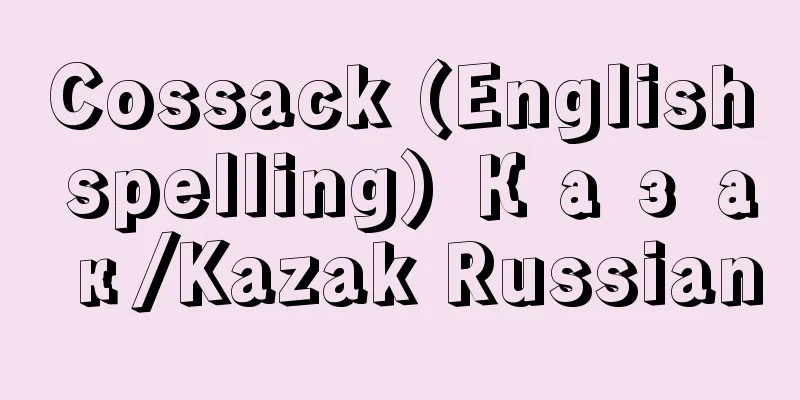Cossack (English spelling) Казак/Kazak Russian

|
Also called Cossacks or Cossacks. The original meaning comes from the Turkic word meaning "reckless" or "free man." The first Cossacks were Turkic or Tatar bandits and warriors, but from the time of Dmitry Donskoy some Cossacks served the Grand Prince of Moscow. Later, from the 15th to 16th centuries, the term came to refer to a group of peasants who fled to the steppe region on the outskirts, disliking the strengthening rule of the Principality of Moscow and the Kingdom of Poland, and from the 18th to the early 20th centuries, it came to refer to a special social class that was obligated to serve in the military. Due to the strengthening of serfdom in Russia, famines, and the oppression of Ivan IV (reigned 1533-84), some of the peasants of the Moscow principality fled to the Don River basin, where they formed a free military community that was exempt from taxes. These groups, who came to be called the "Don Cossacks," became a particularly powerful political force during the Time of Troubles (Smuta, 1606-13), and by the time Mikhail Romanov ascended to the throne in 1613, they had come to be known as the "Great Don Army." Meanwhile, the Cossacks who fled to the Dnieper River basin were called the "Zaporozhye Cossacks" (meaning "beyond the rapids") because they established their base on an island in the rapids. They elected a leader called an ataman, and all important matters were decided at a general assembly called a "rada." The main occupations of the Cossacks were hunting, fishing, beekeeping, and livestock farming, and they sometimes engaged in plundering. Agriculture was mainly carried out by non-Cossack peasants called inogorodnyi who lived in Cossack villages. Oppression of the Zaporozhian Cossacks in Poland led to the Bogdan Khmelnytsky Rebellion (1648), and the strengthening of the Russian government's control over the Don Cossacks led to the Stenka Razin Rebellion (1670-71). The last large-scale Cossack rebellion against the Russian government was the Pugachev Rebellion (1773-75). After this, the Cossacks were placed under the control of the central government, and in 1827 a decree was issued appointing the crown prince as ataman of all Cossack corps. Cossacks also advanced eastward, and in the 16th and 17th centuries, led by atamans such as Yermak and Atlasov (?-1711), they made expeditions from Siberia to the Far East. From the mid-18th century to the end of the 19th century, new Cossack military districts were created along the southern border of the Russian Empire, and by 1916, the number of Cossacks had increased to 13 military districts, with a population of 4.43 million (including 285,000 soldiers). In exchange for land, they were obligated to serve in the military (for men over 18 years of age, 20 years). The Russian government used these Cossacks as a pillar of the imperial government and to oppress revolutionary and labor movements. Literary works depicting Cossack life include Gogol's Taras Bulba, L. Tolstoy's The Cossacks, and Sholokhov's Quiet the Don. [Tsuguo Tonokawa] [References] | |Source: Shogakukan Encyclopedia Nipponica About Encyclopedia Nipponica Information | Legend |
|
コザック、カザークともいう。もとの意味は「向こう見ず」とか「自由な人」を意味するチュルク語からきている。最初のコサックは、トルコ人やタタール人の山賊や戦士であったが、ドミトリー・ドンスコイの時代からモスクワ大公に仕える者も現れてきた。その後15世紀から16世紀にかけて、モスクワ公国やポーランド王国の支配の強化を嫌って、辺境のステップ地帯に逃亡する農民の集団をさすようになり、さらに18世紀から20世紀初頭においては、軍役奉仕を義務とする特別の社会層をさすようになった。 ロシアにおける農奴制の強化、飢饉(ききん)、イワン4世(在位1533~84)の圧政から、モスクワ公国の農民の一部はドン川流域に逃亡し、そこに、税を免れて自由な軍事的共同体をつくった。「ドン・コサック」とよばれるようになるこれらのグループは、動乱時代(スムータ、1606~13)とくに大きな政治勢力となり、1613年ミハイル・ロマノフが即位するころには「ドンの大軍団」と称されるまでになった。一方ドニエプル川の流域に逃れたコサックは、早瀬の中の島に本拠を置いたところから、「ザポロジエ(早瀬の向こうの意)のコサック」とよばれた。彼らはアタマンとよばれる頭目を選挙で選び、すべて重要事項はラーダという全員集会で決めた。 コサックの生業は狩猟、漁業、養蜂(ようほう)業、牧畜などが主で、ときに略奪をも働いた。農業は、コサックの村に住むイノゴロードニィとよばれる非コサックの農民が主として行った。ポーランドのザポロージエ・コサックに対する圧迫はボグダン・フメリニツキーの乱(1648)を、ロシア政府のドン・コサックに対する支配の強化はステンカ・ラージンの乱(1670~71)を生んだ。ロシア政府に対するコサックの最後の大規模な反乱はプガチョフの乱(1773~75)であった。これ以後、コサックは中央政府の管理下に置かれ、1827年には皇太子をもって全コサック軍団のアタマンとするという法令も出た。 コサックは東方にも進出し、16世紀から17世紀にかけてイェルマークやアトラーソフВладимир Васильевич Атласов/Vladimir Vasil'evich Atlasov(?―1711)などのアタマンに率いられて、シベリアから極東まで遠征した。また、18世紀のなかばから19世紀の末までに、ロシア帝国の南部国境沿いに新しいいくつかのコサック軍管区がつくられ、1916年には13軍管区、443万(うち軍人28万5000)の人口を数えるまでになった。彼らは土地を与えられるかわりに軍役奉仕(18歳以上の男子で20年間)を義務づけられた。ロシア政府はこれらのコサックを帝政の支柱として、革命運動や労働運動を弾圧するのに用いた。コサックの生活を描いた文学作品に、ゴーゴリの『タラス・ブーリバ』、L・トルストイの『コサック』、ショーロホフの『静かなドン』などがある。 [外川継男] [参照項目] | |出典 小学館 日本大百科全書(ニッポニカ)日本大百科全書(ニッポニカ)について 情報 | 凡例 |
<<: Gozasso (English spelling) Wǔ zá zǔ
Recommend
Umbonium
...A snail shell of the family Celastridae, commo...
codominant
… Because there is no dominance or inferiority be...
Kamikurumazuka - Kamikurumazuka
...However, not all activities that qualify as ex...
Trim-aksjon (English notation) Trimaksjon
…It means physical fitness. The original meaning ...
Kihaccho - Kihaccho
...Kihassoku is the name used mainly in various p...
Horse hill road - Umayasakamichi
...In the reign of Ojin, this was the place where...
Riichi Yokomitsu
Novelist. Born on March 17, 1898 (Meiji 31) in Hi...
Yamakawa [town] - Yamagawa
Located in Ibusuki District, Kagoshima Prefecture,...
Royal Touch
"King's Touch Cure." This was a mira...
Key number - key number
〘noun〙① A job title under the Finance Magistrate i...
Watercress - Watercress
→ Sanukite Source : Heibonsha Encyclopedia About M...
False Dmitry - False Dmitry (English spelling) Lzhedmitrii
A man who pretended to be Dmitry (1582-91), the yo...
Explanation of the Nakatomi Harae Kunge
A book on Ryobu Shinto created in the Kamakura per...
Catopsilia pyranthe
A butterfly of the family Pieridae in the order Le...
Tokugawa Iemitsu
The third Shogun of the Edo Shogunate (in office ...









